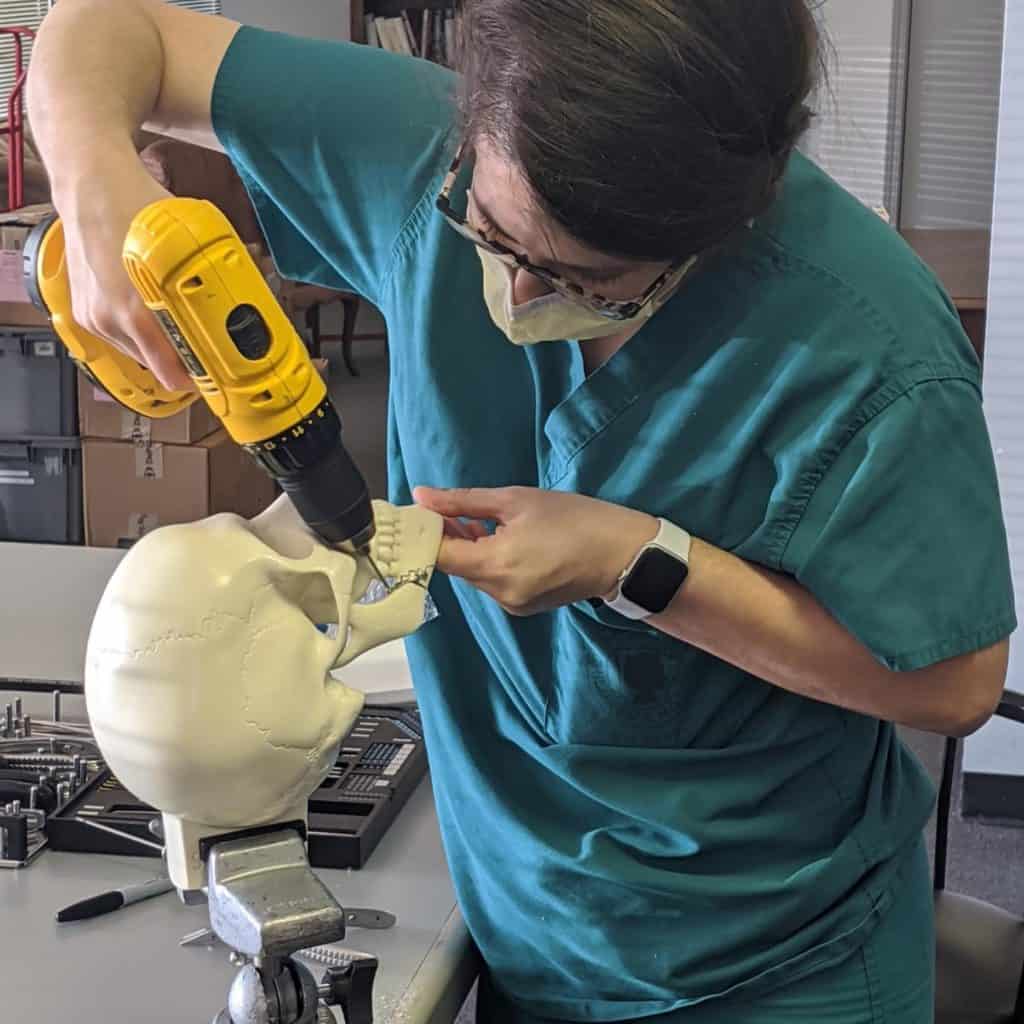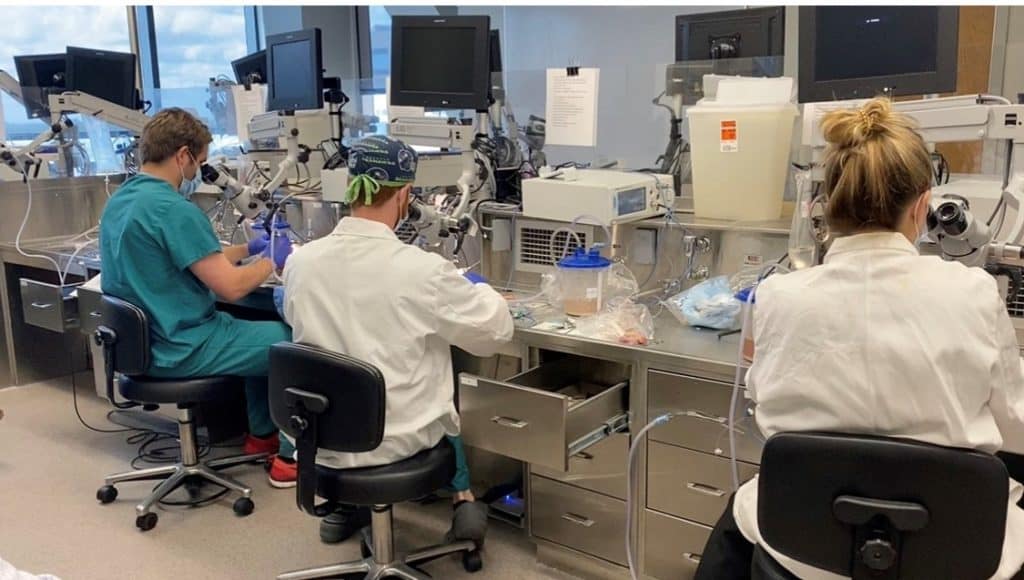UAMS Otolaryngology Fast Facts
- Five Year Residency
- Three Residents Per Year
- 17:15 faculty: resident ratio
- 17 Fellowship-trained faculty in six subspecialties
- Three Hospitals Covered (UAMS, Arkansas Children’s, John L. McClellan Memorial Veterans Hospital)
- Primary Call: Q6 PGY2, Q10 PGY-3
- 47 Faculty and Resident Publications, 2018/19
Scope
The Otolaryngology Residency Program at Arkansas is as broad in scope as any offered in the country. We are currently operating a 3-3-3-3 program, with a total of twelve residents in the PGY 2-5 years in Otolaryngology and a total of three residents in the PGY-1 year in Otolaryngology, thus making all five years categorical. Residents move to a new clinical rotation every one to two months, with one resident on research. Comprehensive clinical programs are offered in the areas of
- Head and Neck Oncology
- Otology/Neurotology
- Facial Plastic and Reconstructive Surgery
- Pediatric Otolaryngology
- Laser Therapy and Surgery
- Skull Base Surgery
- Rhinology
- Cleft Lip and Palate Surgery
- Maxillofacial Trauma
- Voice & Swallowing
- Allergy
- General ENT
- Obstructive Sleep Apnea
- Geriatric Otolaryngology
- Vascular Malformations
- Head and Neck Endocrinology
Comprehensive Education
The residency program in otolaryngology provides residents with education in comprehensive medical and surgical care of patients with diseases and disorders that affect the ears, the upper respiratory and upper alimentary systems, and related structures of the head and neck. It includes core knowledge, skills, and understanding of the basic medical sciences relevant to the head and neck; the upper respiratory and upper alimentary systems; endocrinology; neurology; and the communication sciences, including knowledge of audiology, speech pathology, and audiologic and speech rehabilitation. The educational program also includes the clinical aspects of diagnosis and medical and/or surgical therapy for prevention/treatment of diseases, neoplasms, deformities, disorders, and/or injuries of the ear, the upper respiratory and upper alimentary systems, the face, the jaw, and other head and neck systems as well as all aspects of head and neck oncology, and facial plastic and reconstructive surgery.

Residents are closely supervised in all aspects of training. One of the strongest points of our program is the one-on-one resident teaching that our staff-to-resident ratio allows. Our staff firmly believes in the philosophy that residents should not learn by trial and error, but from the staff’s experience. Since the training of the staff is varied, the residents are exposed to several ways of approaching any situation.
All residents are required to attend departmental didactic conferences, which consist of at least three hours of teaching each week. The Core Curriculum Conference, Morbidity and Mortality Conference, and the Head & Neck Tumor Conference each comprise one hour of training each week. Journal Club and the Grand Rounds Conference are held monthly. A Basic Science review course is held weekly during the summer months. A monthly temporal bone course is also held throughout the majority of the year. In addition, the temporal bone dissection laboratory is maintained for both supervised and independent dissection to help residents improve their skill in otology. An annual course is provided every spring with alternating topics between allergy with practical applications and rhinology with cadaver dissections.
Residents are also required to participate in the American Academy of Otolaryngology — Head and Neck Surgery’s Home Study Course during their PGY-2 year and, during their PGY-3 though PGY-5 years, they are allowed to choose a study course of their liking in preparation for the Otolaryngology In-Service exam that is taken every spring. Beginning in December of each year a three-month intensive in-service exam review is offered to the otolaryngology residents. This review is guided by the Program Director along with faculty participation. All graduates who have trained in the department since 1974 have passed their Otolaryngology Boards.
In addition to these regularly scheduled conferences, our residents attend the annual meetings of the Arkansas Society of Otolaryngology — Head and Neck Surgery, which feature distinguished guest speakers from around the country. Residents also attend pertinent local continuing education conferences in addition to at least two national otolaryngology meetings or courses.
Each resident is expected to complete a research project in each of the last four years of otolaryngology training, or design and complete a single extended research project throughout the five years. PGY-2 residents are expected to participate in and complete a quality improvement project mentored by an otolaryngology faculty member. An annual Resident Research Day is held for presentation of the research results, and awards are given to the top two projects. Innovative research is encouraged.
Rotations
The PGY-1 resident will complete rotations in the following manner:
- Three months general surgery covering:
- one in Pediatric Surgery
- one in General Surgery
- one in Surgical Intensive Care Unit
- Three months covering:
- Anesthesia
- Neuroradiology
- Ophthalmology
- Six months of ENT
- one month of General Otolaryngology
- two months of Head and Neck
- three months of Pediatric Otolaryngology

The second through fifth-year residents will actively participate in the outpatient and inpatient care of otolaryngology patients at the three teaching sites: UAMS, Arkansas Children’s Hospital, and the John L. McClellan Memorial Veteran’s Hospital. Residents are provided faculty supervision and progressive responsibilities in the clinics and operating rooms. Research months are provided for the PGY-2 through PGY-5 years.
